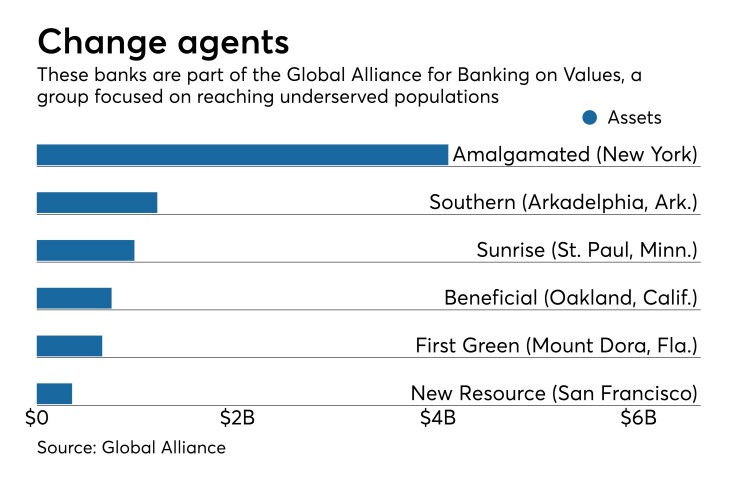Amalgamated Bank in New York, which recently agreed to buy a West Coast institution, has big plans to operate in a number of major U.S. cities.
The $4.1 billion-asset union-owned bank
Amalgamated, for its part, envisions becoming an institution with operations in other left-leaning cities such as Austin, Texas; Boston; and Chicago, said Keith Mestrich, the bank’s president and CEO. Expansion could involve branches or acquisitions.
“I don’t know that we will ever replicate what Citi or Chase does,” Mestrich said. “We we’ll be looking for other cities with high concentrations of progressive organizations like unions and nonprofits.”

Amalgamated already does business in Washington, while the $353 million-asset New Resource operates in Boulder, Colo.
The expansion is noteworthy given that Amalgamated has earned a reputation for being antithetical to mainstream banking. It banks the Democratic National Committee and held funds for the Occupy Wall Street movement.
Mergers between values-based institutions are rare, said Ken LaRoe, founder and chairman of First Green Bancorp in Mount Dora, Fla.
The $652 million-asset First Green also marches to its own beat. The company, which supports green initiatives, recently began
Banks with a specific mission often
Amalgamated and New Resource had several things in common. Notably, both are certified B Corps, a designation for companies that use their clout to address social and environmental problems, and members of the Global Alliance for Banking on Values.
New Resource has traditionally focused on lending to sustainable companies and organizations.
Each bank is based in a city with a large union population, Mestrich noted.
Mergers like the one between Amalgamated and New Resource fulfill a goal of the Global Alliance, said LaRoe. (First Green is also among the 15 U.S. and Canadian institutions listed as members on the Global Alliance
“That was everyone’s dream, to actually start creating those synergies, marriages and link- ups,” LaRoe said of the Global Alliance. First Green, which has also been looking to buy a like-minded institution, has struggled to find a suitable partner in the Southeast.
Would First Green have an interest merging with Amalgamated?
“Absolutely,” LaRoe said without hesitation.
The five-year plan for Amalgamated includes “a vibrant digital consumer presence,” Mestrich said. The bank, which is building a national digital banking platform, has been recruiting staff from other institutions to handle the project.
“I don’t see why we couldn’t be a $20 billion bank,” Mestrich added.
New Resource, meanwhile, will be able to make bigger loans when the deal closes. It will also start providing consumer banking services.
Talks with Amalgamated began this summer as New Resource began thinking about what it might look like over the next five to 10 years, said President and CEO Vincent Siciliano, who plans to retire and become a consultant after the deal closes.
“This will make the framework for a national values-based bank,” added Siciliano, who also wants to join more boards. “That’s new for our country. No one else is doing that. We have to fill in a lot of geographic gaps, but it’s an exciting vision for the future.”





